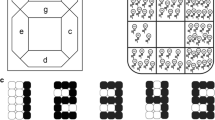Abstract
We introduce a specialized module for molecular programming systems, designed to accelerate the comparison of species concentrations. Like in electronics, co-processors are important to increase the speed of crucial tasks. Concentration comparison is a central operation in DNA computing, similar to variable comparison in its electronic equivalent. This work represents the first attempt to make multiple comparison in a single step, while keeping the mechanism as optimized as possible with respect to enzymatic load.
We first demonstrate a possible implementation of the system, showing that there is no theoretical barrier to the design. In particular, it allows enough freedom in the sequence design to work around potential cross-talks in the system.
We then add our co-processor to a specific DNA computing paradigm, the PEN toolbox, and use it to implement an optimized tristable circuit and compare its performance to the standard design approach existing in the literature. Our design shows improved time response and lower impact on the saturation of key enzymes, making it a useful module for designing large systems.
Similar content being viewed by others
References
Tsuda S., Zauner K.-P., Gunji Y.-P.: “Robot control with biological cells,”. Biosystems 87(2-3), 215–223 (2007)
Hagiya M., Konagaya A., Kobayashi S., Saito H., Murata S.: “Molecular robots with sensors and intelligence,”. Accounts of Chemical Research 47(6), 1681–1690 (2014)
Douglas S.M., Bachelet I., Church G.M.: “A logic-gated nanorobot for targeted transport of molecular payloads,”. Science 335(6070), 831–834 (2012)
Gu H., Chao J., Xiao S.-J., Seeman N.C.: “A proximity-based programmable DNA nanoscale assembly line,”. Nature 465(7295), 202–205 (2010)
Smith L.M.: “Nanotechnology: Molecular robots on the move,”. Nature 465(7295), 167–168 (2010)
Padirac A., Fujii T., Rondelez Y.: “Nucleic acids for the rational design of reaction circuits,”. Current opinion in biotechnology 24(4), 575–580 (2012)
Montagne, K., Plasson, R., Sakai, Y., Fujii, T. and Rondelez, Y., “Programming an in vitro DNA oscillator using a molecular networking strategy,” Molecular systems biology, 7, 1, 2011.
Franco, E., Friedrichs, E., Kim, J., Jungmann, R., Murray, R., Winfree, E. and Simmel, F. C., “Timing molecular motion and production with a synthetic transcriptional clock,” in Proc. of the National Academy of Sciences, 108, 40, E784-E793, 2011.
Padirac, A., Fujii, T. and Rondelez, Y., “Bottom-up construction of in vitro switchable memories,” in Proc. of the National Academy of Sciences, 109, 47, E3212-E3220, 2012.
Qian L., Winfree E.: “Scaling up digital circuit computation with DNA strand displacement Cascades,”. Science 332(6034), 1196–1201 (2011)
Qian L., Winfree E., Bruck J.: “Neural network computation with DNA strand displacement cascades,”. Nature 475(7356), 368–372 (2011)
Giordano, G., Franco, E. and Murray, R. M., “Feedback architectures to regulate flux of components in artificial gene networks, in the American Control Conference (ACC) 2013, IEEE, pp. 4747–4752, 2013.
Hagiya, M., Kawamata, I. and Aubert, N., “Towards persistent molecular computers for molecular robots,” in DNA Computing and Molecular Programming 19th International Conference, DNA19, extended abstract, 2013.
Aubert, N., Dinh, Q. H., Hagiya, M., Iba, H., Fujii, T., Bredeche, N. and Rondelez, Y., “Evolution of cheating DNA-based agents playing the game of rock-paper-scissors,” in Advances in Artificial Life, ECAL, 12, pp. 1143–1150, 2013.
Tanaka, F., Tsuda, T. and Hagiya, M., “Towards DNA comparator: the machine that compares DNA concentrations,” in DNA Computing, Springer, pp. 11–20, 2009.
Zhang D.Y.: “Cooperative hybridization of oligonucleotides,”. Journal of the American Chemical Society 133(4), 1077–1086 (2010)
Aubert N., Mosca C., Fujii T., Hagiya M., Rondelez Y.: “Computer-assisted design for scaling up systems based on DNA reaction networks,”. Journal of The Royal Society Interface 11(93), 20131167 (2014)
Aubert, N., “Assisted Design of DNA Computing Systems: the DNA Toolbox and Beyond,” PhD thesis, The University of Tokyo, 2014.
Rudi, K., Kroken, M., Dahlberg, O., Deggerdal, A., Jakobsen, K. and Larsen, F., “Rapid, universal method to isolate PCR-ready DNA using magnetic beads,” BioTechniques, 22, 3, pp. 506–511, 1997.
Zadeh J.N., Steenberg C.D., Bois J.S., Wolfe B.R., Pierce M.B., Khan A.R., Dirks R.M., Pierce N.A.: “Nupack: analysis and design of nucleic acid systems,”. Journal of computational chemistry 32(1), 170–173 (2011)
Zhang D.Y., Winfree E.: “Control of DNA strand displacement kinetics using toehold exchange,”. Journal of the American Chemical Society 131(47), 17303–17314 (2009)
Aubert N., Rondelez Y., Fujii T., Hagiya M.: “Enforcing logical delays in DNA computing systems,”. Natural Computing 13(4), 559–572 (2014)
Wolfram Research, Inc., Mathematica 8., Wolfram Research, Inc., 2010.
Fujii T., Rondelez Y.: “Predator-prey molecular ecosystems,”. ACS nano 7(1), 27–34 (2012)
Lipton, R. J. et al., “DNA solution of hard computational problems,” Science, 268, 5210, pp. 542–545, 1995.
Braich R.S., Chelyapov N., Johnson C., Rothemund P.W., Adleman L.: “Solution of a 20-variable 3-sat problem on a DNA computer,”. Science 296(5567), 499–502 (2002)
Sakamoto K., Gouzu H., Komiya K., Kiga D., Yokoyama S., Yokomori T., Hagiya M.: “Molecular computation by DNA hairpin formation,”. Science 288(5469), 1223–1226 (2000)
Thachuk, C. and Condon, A., “Space and energy efficient computation with DNA strand displacement systems,” in DNA Computing and Molecular Programming, Springer, pp. 135–149, 2012.
Author information
Authors and Affiliations
Corresponding author
About this article
Cite this article
Aubert-Kato, N. A Specialized Tri-species Comparator for the DNA PEN Toolbox. New Gener. Comput. 33, 231–252 (2015). https://doi.org/10.1007/s00354-015-0306-3
Received:
Revised:
Published:
Issue Date:
DOI: https://doi.org/10.1007/s00354-015-0306-3




